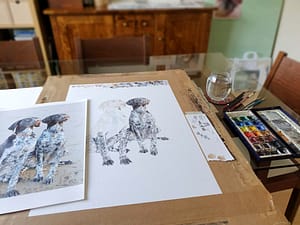
Works on paper need to be protected behind glass so the issue of framing watercolours and drawings is not one you can avoid. There are several considerations to be taken into account when choosing the correct frame for these more delicate works of art.
Did you know that the world’s largest watercolour painting was completed in 2017 by American artist Barbara Prey? At 8 x 15 feet this work is truly astounding. As an artist I can’t imagine painting something this size in the demanding medium of watercolour. Now can you imagine how to overcome the problem of getting it framed?
Luckily most of us will never have to deal with this colossal problem. However, if you have just commissioned an original watercolour portrait or a pencil drawing, you will have to consider how to get it framed once you receive it.
What type of glass? Which colour of frame? What style of moulding? Which type of mount? How much will it cost?
 When framing watercolours or drawings your choice of the type of frame is largely narrowed down to using the Gallery Frame style. This is the classic frame choice for many artworks – they include a mount which gives the painting or drawing space. This enhances the image and effectively creates a frame within a frame. You can choose a single or double mount in classic ivory which tends to display images to the optimum. Or you may wish to choose a coloured mount if you want a more dramatic finish. This frame comes with glass to protect the painting or drawing.
When framing watercolours or drawings your choice of the type of frame is largely narrowed down to using the Gallery Frame style. This is the classic frame choice for many artworks – they include a mount which gives the painting or drawing space. This enhances the image and effectively creates a frame within a frame. You can choose a single or double mount in classic ivory which tends to display images to the optimum. Or you may wish to choose a coloured mount if you want a more dramatic finish. This frame comes with glass to protect the painting or drawing.
Mount Options
Single or double mount? When framing watercolours the choice of mount is very important and the wrong choice can distract from the artwork. Many people opt for a classic uncluttered finish of an ivory double mount.
This is generally my favoured choice as it displays the painting beautifully. I always prefer a double mount over a single as it creates a more professional finish. Using ivory or off-white is preferable to pure white which is often too stark. This can work well though with a black and white image as long as the white in the artwork is ice white too.


Double mounts create a more professional finish and are recommended for original artwork.
Adding colour
Double mounts can also offer the choice of using colour as an accent, with the inside mount picking out a colour used within the painting. This method adds visual interest and creates a more definite frame-within-a-frame look. It is an excellent way of emphasising a particular colour in the painting as it draws your eye to this hue.
Making the final decision on which colour to enhance will depend on the artwork as well as your personal preference for particular colours. How do you decide? Lay the different options against the painting (along with the frame choices), stand back, look at it for a while. Try moving the mount to the top of the painting and looking again. A colour that looks good next to the foreground in an artwork may not work so well with the background which could be a different colour. There may be two colours that work well in which case your frame choice may ultimately decide for you. If you are using a grey frame, a grey/blue mount accent would probably look better than a green/grey mount.


For a larger painting, an embossed double-mount is often used as the larger size can benefit from a more striking finish. On small scale works this would look overpowering. This option was used here for a large watercolour portrait. An accent colour of slate grey was also introduced in the form of a narrow band. This matched the frame as well as the grey hues used throughout the portrait.
Glass options
You may not think there are any decisions to be made regarding glass. Most people naturally assume it’s only the frame moulding and mount that they need to worry about. However, there are different types and you can see from this picture that they have quite a profound effect on how your painting will look once framed.
 Conservation glass is the standard choice used with frames. The majority of glazed pictures in your home will probably contain this type of glass. A superior option is Tru Vue Museum glass. This is far less reflective so it feels as though you are viewing an artwork before it has been framed. Colours are more true and even the texture of the paper surface is more discernible.
Conservation glass is the standard choice used with frames. The majority of glazed pictures in your home will probably contain this type of glass. A superior option is Tru Vue Museum glass. This is far less reflective so it feels as though you are viewing an artwork before it has been framed. Colours are more true and even the texture of the paper surface is more discernible.
You will pay more for this type of glazing but if you have the budget and it’s a special piece you are framing then the extra is definitely worth it.
Acrylic options are also available. This material has the advantage of being considerably lighter than glass. This could be a good choice if your artwork is very large or needs to be shipped. Standard acrylic tends to scratch easily though which is a drawback. The equivalent museum grade acrylic, Optium Museum, has been engineered to be scratch resistant making it an excellent choice if you don’t want glass.
Ready-made frames versus bespoke framing
You may ask yourself whether the extra expense of going to a framer is really worth it. There are some attractive ready-made frames available from a variety of outlets including your local supermarket these days.
My advice is to always get an original painting or drawing framed by a professional.
They will offer a bespoke service and a superior product which will show your artwork to its best. Professional framers vary. If you are wanting a guaranteed expert framing service then look for framers who are members of the Fine Art Trade Guild.
 To be in the guild they have to meet very high standards. This means you should be assured of a top-notch service and a superior product. Alongside the usual range of frames on offer, they will have a range of very beautiful (and often expensive) mouldings to choose from. They will also have superior mounting options on offer. This includes whitecore mountboard, conservation mountboard and cotton museum mountboard. Expect to pay anything from £200 upwards but bear in mind you will be getting a really fantastic frame.
To be in the guild they have to meet very high standards. This means you should be assured of a top-notch service and a superior product. Alongside the usual range of frames on offer, they will have a range of very beautiful (and often expensive) mouldings to choose from. They will also have superior mounting options on offer. This includes whitecore mountboard, conservation mountboard and cotton museum mountboard. Expect to pay anything from £200 upwards but bear in mind you will be getting a really fantastic frame.
If you have gone to the expense of commissioning a special portrait, why stop short of displaying it well?
Rachel is a professional artist specialising in portraiture. A graduate of Glasgow School of Art, her career over the last 30 years has included painting, teaching and lecturing, and freelance designing. She has exhibited at the Royal Scottish Academy and in 2020 was a finalist in the Scottish Portrait Awards.
-
If you haven't had a reply within 24 hours please check your junk folder






